
[Source: Nick Catford]
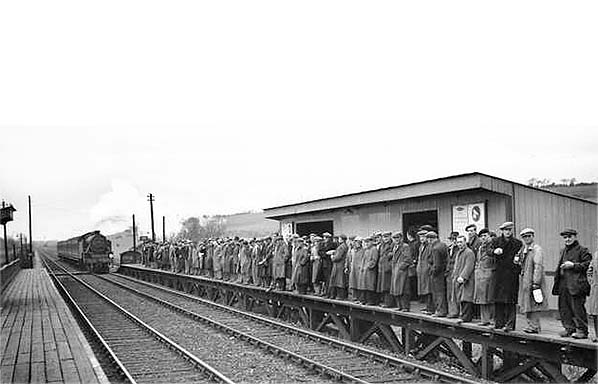 Colliery workers at Chislet Colliery Halt c1952 waiting for the Ramsgate service which is approaching. Before Hersden village was built, the majority of colliery workers commuted from Ramsgate. This view shows the original timber platforms and shelters as built. These were later replaced by concrete platforms while the old shelters were retained. The entrance to the station is at the west end of the platform, note the barrow crossing for access to the up platform, a footbridge was later provided here c early 1960s.
Photo from John Mann collection 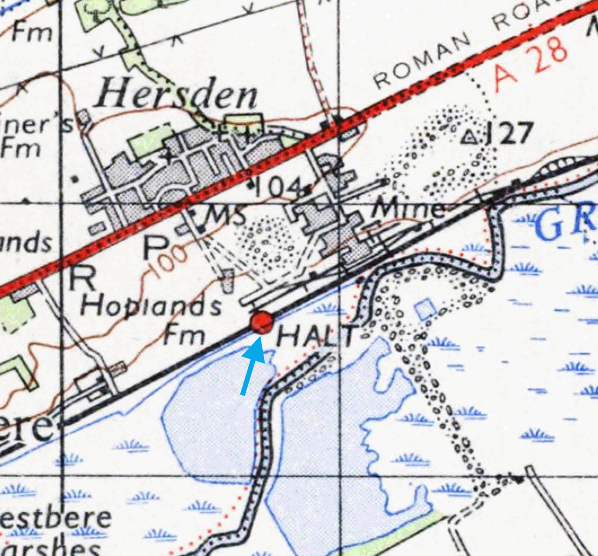 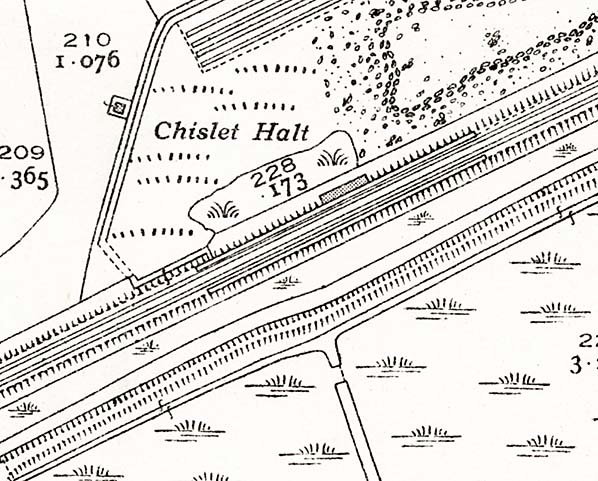
1941 1:2,500 OS map only shows a shelter on the down platform.
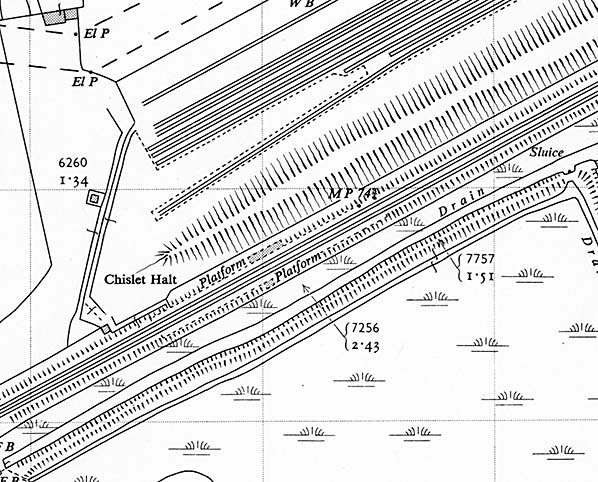 1956 1:2,500 OS map. A small building has appeared at the end of the path to the down platform. This is assumed to have been the ticket office.
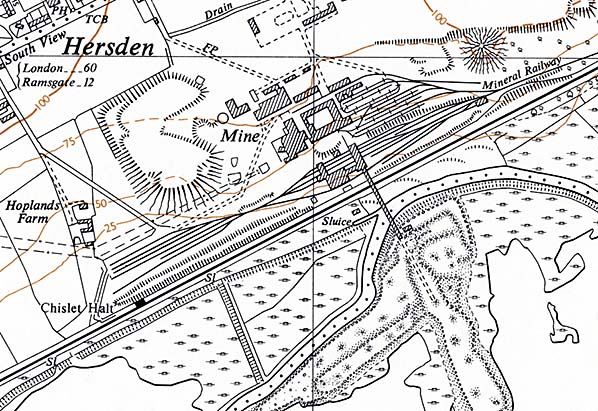
1960 OS maps-hows the halt and Chistlet Colliery.
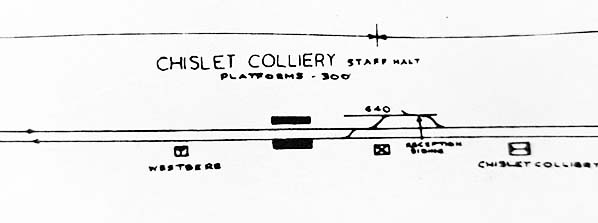
halt_old4.jpg)
1947 aerial view of Chislet Colliery the two platforms of the halt are seen top left. A boarded barrow crossing is seen at the west end of the platform for assess to the other platform. A footbridge was provided here in the early 1960s. Click here to see a larger version.
Photo from Britain From Above reproduced with permission 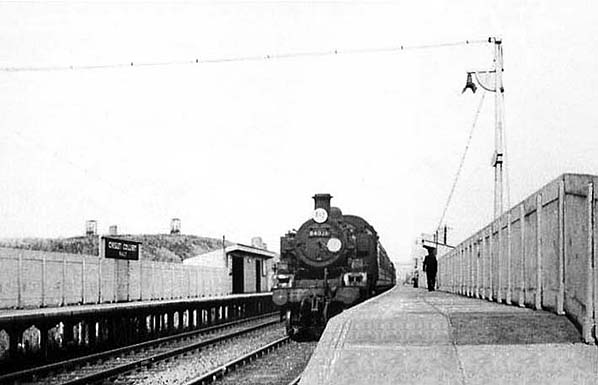 Looking east along the up platform at Chislet Colliery Halt c.early 1960s after the timber platforms have been replaced. A passenger train hauled by 84021 a BR standard class 2 2-6-2 T has stopped to pick up passengers. This class was designed at Derby Works and introduced in 1953. The design derived from the LMS Ivatt Class 2 2-6-2T which BR had built after nationalisation. This loco was built at Darlington in 1957 for use on the Southern Region and was allocated to the Eastern Section depot at Ashford for use on the lines over Romney Marsh and local trains on the Margate via Canterbury West route. The loco was withdrawn in 1964 after only 7 years in service. Looking east along the up platform at Chislet Colliery Halt c.early 1960s after the timber platforms have been replaced. A passenger train hauled by 84021 a BR standard class 2 2-6-2 T has stopped to pick up passengers. This class was designed at Derby Works and introduced in 1953. The design derived from the LMS Ivatt Class 2 2-6-2T which BR had built after nationalisation. This loco was built at Darlington in 1957 for use on the Southern Region and was allocated to the Eastern Section depot at Ashford for use on the lines over Romney Marsh and local trains on the Margate via Canterbury West route. The loco was withdrawn in 1964 after only 7 years in service. Photo from John Mann collection 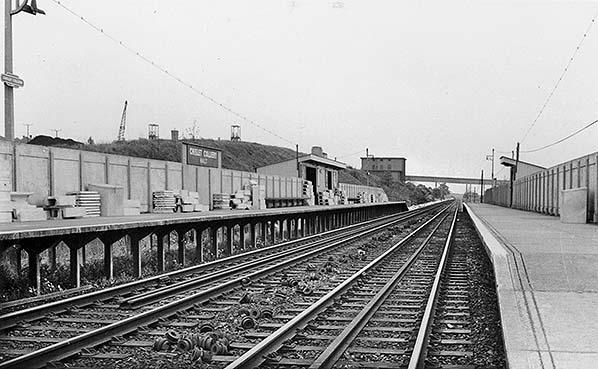
Chislet Colliery Halt looking east c.1960. Note Southern Region totem signs have been fitted.
Photo
from John Mann collection
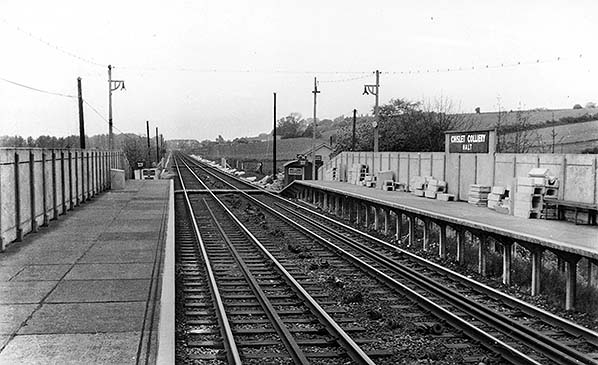
Chislet Colliery Halt looking west from the up platform c1960, shortly before a footbridge was provided at the west end of the platform to replace the barrow crossing. Note hut at the end of the down platform, this would have been the ticket office.
Photo from John Mann collection 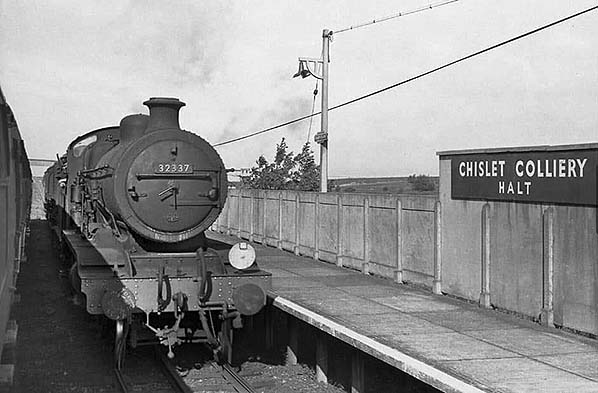
K class 32337 is seen passing the down platform at Chislet Colliery Halt c.early 1960s. It was probably on the shunt down to Minster from where it would return to Ashford. The recently built footbridge can be made out beyond the station. The K class were powerful 2-6-0 mixed traffic locomotives designed by L. B. Billinton for the London, Brighton and South Coast Railway in 1913. They appeared shortly before the First World War. 32337 was built at Brighton and entered service Sept 1913. She was withdrawn in December 1962 and would have been a prime candidate for preservation on the Bluebell Line, but they declined the opportunity. Stored in the goods yard at Hove, together with several others of this class, 32337 was sold to R A King of Norwich for scrap in March 1964.
Photo from John Mann collection halt_old3.jpg) A good general view of Chislet Colliery Halt in 1966 seen from the footbridge. The colliery is seen to the left. The signal box which opened in 1961 can be made out beyond the up platform. Before Hersden village was built for colliery workers, most workers commuted from Ramsgate so the shelter on the down platform (towards Ramsgate) is twice the length of that on the up platform.
Photo by Graham Larkbey 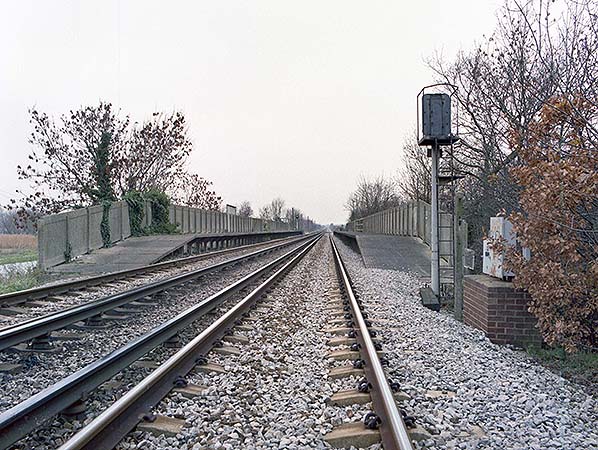
Looking west towards Chislet Halt in November 1980
Photo
by Nick Catford
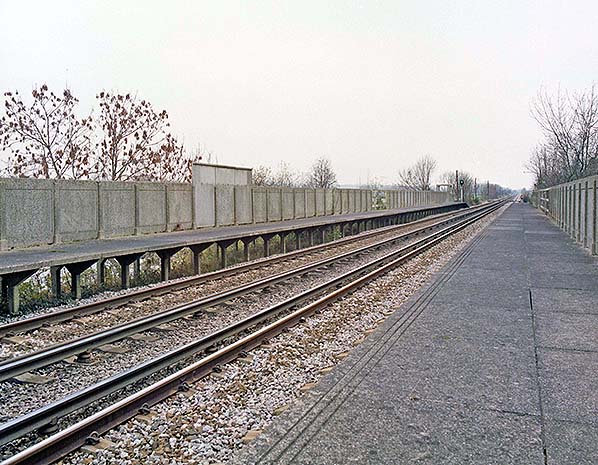
Looking west along the down platform at Chislet Halt in November 1980. A break in th concrete wall at the back of both platforms indicates where the waiting shelters would have been. The footbridge at the west end of the station has been demolished.
Photo by Nick Catford 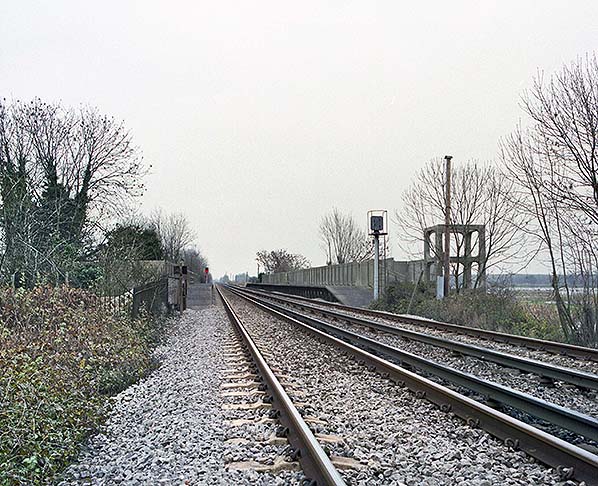
Looking east towards Chislet Halt in November 1980. The concrete framework on the right is the remains of the short lived footbridge. The bridge was demolished overnight in the 1970s and the demolition team ran out of time which is why this support tower remains.
Photo by Nick Catford 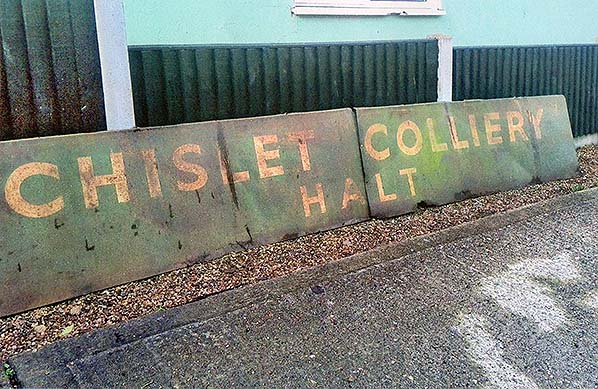 One of the two running in boards was donated to a local mining historian in 2014. The sign has now been restored and is on display in the Lamp Room Restaurant at Betteshanger Park.
Photo by Robert Llewellyn 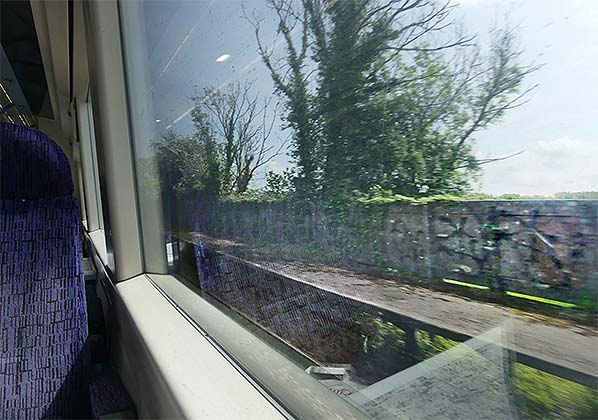 With no public access the only way to see the two platforms at Chislet Halt is from a passing train as seen here in June 2023.
Photo by Sunil Prasannan
|


 Notes: Chislet Colliery started production in 1919 and a halt was opened on the Ashford - Ramsgate line to serve it. As local housing was inadequate for employees at the colliery, most of the workers came from Ramsgate. It first appeared in a public timetable in June 1920. The halt was in the parish of Westbere. In 1924 the Chislet Colliery Housing Society was formed to build a mining village of 300 houses. The village was originally called Chislet Colliery Mining Village. In 1929 the village was renamed Hersden to distinguish it from the original village of Chislet. Although the mine closed in 1969, the Chislet Colliery Welfare Club remains. Work in the Kent Coalfield was the main source of employment in the village until the closure of the last Kent colliery in the 1980s.
Notes: Chislet Colliery started production in 1919 and a halt was opened on the Ashford - Ramsgate line to serve it. As local housing was inadequate for employees at the colliery, most of the workers came from Ramsgate. It first appeared in a public timetable in June 1920. The halt was in the parish of Westbere. In 1924 the Chislet Colliery Housing Society was formed to build a mining village of 300 houses. The village was originally called Chislet Colliery Mining Village. In 1929 the village was renamed Hersden to distinguish it from the original village of Chislet. Although the mine closed in 1969, the Chislet Colliery Welfare Club remains. Work in the Kent Coalfield was the main source of employment in the village until the closure of the last Kent colliery in the 1980s.
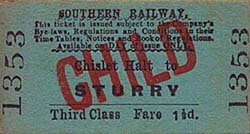 Chislet Colliery Halt had two 300' platforms initially built of timber but rebuilt in concrete c.late 1950s. The main shelter was on the down side with a smaller shelter on the up side. A barrow crossing at the west end of the platform gave access to the up platform. Passenger access was along a footpath from the colliery to the west end of the down platform. In later years a small hut appeared at the end of the path up to the down platform, this was a ticket office. There was also a hut used by Mrs Williams from Hoplands Farm to sell tea, coffee, sweets and sandwiches. On 27.5.1961 a signal box was opened on the up side to the east of the station. At around the same time a footbridge was provided at the west end of the station.
Chislet Colliery Halt had two 300' platforms initially built of timber but rebuilt in concrete c.late 1950s. The main shelter was on the down side with a smaller shelter on the up side. A barrow crossing at the west end of the platform gave access to the up platform. Passenger access was along a footpath from the colliery to the west end of the down platform. In later years a small hut appeared at the end of the path up to the down platform, this was a ticket office. There was also a hut used by Mrs Williams from Hoplands Farm to sell tea, coffee, sweets and sandwiches. On 27.5.1961 a signal box was opened on the up side to the east of the station. At around the same time a footbridge was provided at the west end of the station.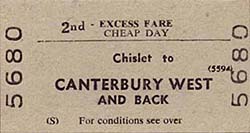 The halt was renamed Chislet Halt on 5.5.1969 as the colliery was to close on 25 July 1969. Although station signs had always shown Chislet Colliery Halt, tickets had always shown Chislet Halt. The halt closed to passengers on 4 October 1971 although it remained in use for a while as a staff halt for the signalman. The signal box was permanently switched out on 28 July 1984 and closed on 14 September 1986. In September 2025 the platforms were still in place, there is no public access but they can be viewed from a passing train.
The halt was renamed Chislet Halt on 5.5.1969 as the colliery was to close on 25 July 1969. Although station signs had always shown Chislet Colliery Halt, tickets had always shown Chislet Halt. The halt closed to passengers on 4 October 1971 although it remained in use for a while as a staff halt for the signalman. The signal box was permanently switched out on 28 July 1984 and closed on 14 September 1986. In September 2025 the platforms were still in place, there is no public access but they can be viewed from a passing train. 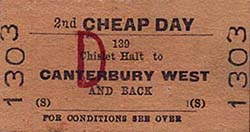 The line was proposed by the South Eastern Railway (SER) as a branch from its main line in April 1834. At the time, coastal towns on the Isle of Thanet such as Margate and Ramsgate were undergoing a rise in popularity as holiday resorts, and railways could be seen as faster and cheaper rivals to the steamboat traffic bringing holidaymakers from London. However, the SER suffered from having no direct access to Thanet on their network except via Ashford. By August 1836, the rival London, Chatham and Dover Railway (LCDR) made its own proposal to serve Thanet. Planning for the line stalled for a while, but by 1840 the SER realised that rival railways were making serious proposals for lines to Thanet.
The line was proposed by the South Eastern Railway (SER) as a branch from its main line in April 1834. At the time, coastal towns on the Isle of Thanet such as Margate and Ramsgate were undergoing a rise in popularity as holiday resorts, and railways could be seen as faster and cheaper rivals to the steamboat traffic bringing holidaymakers from London. However, the SER suffered from having no direct access to Thanet on their network except via Ashford. By August 1836, the rival London, Chatham and Dover Railway (LCDR) made its own proposal to serve Thanet. Planning for the line stalled for a while, but by 1840 the SER realised that rival railways were making serious proposals for lines to Thanet.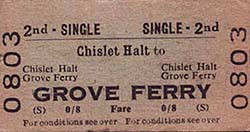 The SER were not convinced the railway would be a success, and so built it as single track, with space to add an additional track if necessary, and crossed roads at level in several places, including Wye, Chartham and Sturry. The line ran through Minster to Ramsgate, then doubled back on a branch line to Margate Sands, which required trains reversing. The overall planned cost was £385,339.
The SER were not convinced the railway would be a success, and so built it as single track, with space to add an additional track if necessary, and crossed roads at level in several places, including Wye, Chartham and Sturry. The line ran through Minster to Ramsgate, then doubled back on a branch line to Margate Sands, which required trains reversing. The overall planned cost was £385,339.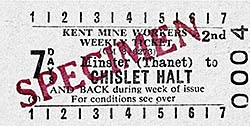 After the LCDR's line reached Dover on 22 July 1861, there was serious competition between the two companies for continental port traffic. The rivalry between the SER and LDCR almost bankrupted both companies, and consequently they formed a joined management committee, known as the South Eastern and Chatham Railway (SECR), in 1899. This then became part of the Southern Railway (SR) as part of the grouping under the Railways Act 1921. In 1924, a 1.5-mile extension began construction between the former SER line at Ramsgate and the former LCDR line at Dumpton Park. This opened on 2 July 1926. At the same time, the former SER branch to Margate Sands closed to passengers, as did the stations at Ramsgate Town and Ramsgate Harbour. The Margate Sands branch line survived as a goods depot until November 1976, when it was closed completely.
After the LCDR's line reached Dover on 22 July 1861, there was serious competition between the two companies for continental port traffic. The rivalry between the SER and LDCR almost bankrupted both companies, and consequently they formed a joined management committee, known as the South Eastern and Chatham Railway (SECR), in 1899. This then became part of the Southern Railway (SR) as part of the grouping under the Railways Act 1921. In 1924, a 1.5-mile extension began construction between the former SER line at Ramsgate and the former LCDR line at Dumpton Park. This opened on 2 July 1926. At the same time, the former SER branch to Margate Sands closed to passengers, as did the stations at Ramsgate Town and Ramsgate Harbour. The Margate Sands branch line survived as a goods depot until November 1976, when it was closed completely.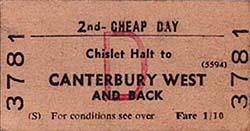
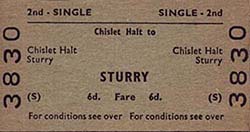
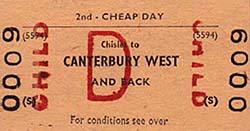

 Home Page
Home Page